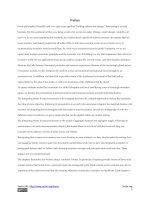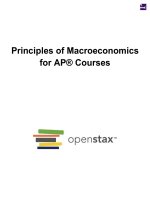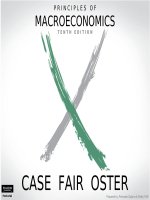Principles of macroeconomics 10e by case fair oster ch01
Bạn đang xem bản rút gọn của tài liệu. Xem và tải ngay bản đầy đủ của tài liệu tại đây (845.09 KB, 53 trang )
PRINCIPLES OF
MACROECONOMICS
PART I Introduction to Economics
TENTH
EDITION
CASE FAIR OSTER
© 2012 Pearson Education, Inc. Publishing as Prentice Hall
Prepared by: Fernando Quijano & Shelly Tefft
PART I Introduction to Economics
© 2012 Pearson Education, Inc. Publishing as Prentice Hall
2 of 53
PART I INTRODUCTION TO ECONOMICS
The Scope and
Method of Economics
1
CHAPTER OUTLINE
Why Study Economics?
To Learn a Way of Thinking
To Understand Society
To Understand Global Affairs
To Be an Informed Citizen
The Scope of Economics
Microeconomics and
Macroeconomics
The Diverse Fields of Economics
PART I Introduction to Economics
The Method of Economics
© 2012 Pearson Education, Inc. Publishing as Prentice Hall
Descriptive Economics and
Economic Theory
Theories and Models
Economic Policy
An Invitation
Appendix: How to Read
and Understand Graphs
3 of 53
PART I Introduction to Economics
economics The study of how
individuals and societies choose to use
the scarce resources that nature and
previous generations have provided.
Economics is the study of how individuals and societies choose
to use the scarce resources that nature and previous generations
have provided. The key word in this definition is choose.
Economics is a behavioral, or social, science. In large measure, it
is the study of how people make choices. The choices that people
make, when added up, translate into societal choices.
© 2012 Pearson Education, Inc. Publishing as Prentice Hall
4 of 37
PART I Introduction to Economics
What is economics?
a.
Economics is the study of money and financial systems.
b.
Economics is the study of business.
c.
Economics is a behavioral science that studies how people
make choices.
d.
Economics is a natural science that studies the resources
that nature and previous generations have provided.
© 2012 Pearson Education, Inc. Publishing as Prentice Hall
5 of 53
PART I Introduction to Economics
What is economics?
a.
Economics is the study of money and financial systems.
b.
Economics is the study of business.
c.
Economics is a behavioral science that studies how
people make choices.
d.
Economics is a natural science that studies the resources
that nature and previous generations have provided.
© 2012 Pearson Education, Inc. Publishing as Prentice Hall
6 of 53
Why Study Economics?
To Learn a Way of Thinking
Three fundamental concepts:
Opportunity cost
Marginalism
PART I Introduction to Economics
Efficient markets
© 2012 Pearson Education, Inc. Publishing as Prentice Hall
7 of 53
Why Study Economics?
To Learn a Way of Thinking
Opportunity Cost
PART I Introduction to Economics
opportunity cost The best alternative that
we forgo, or give up, when we make a
choice or a decision.
scarce Limited.
© 2012 Pearson Education, Inc. Publishing as Prentice Hall
8 of 53
PART I Introduction to Economics
What is opportunity cost?
a.
Opportunity cost refers to costs that cannot be avoided, regardless of
what is done in the future, because they have already been incurred.
b.
Opportunity cost is the value of what we give up by not making the
alternative choice.
c.
Opportunity cost is a business concept that explains why it is
important to consider the additional cost of production, not just the
initial cost, in making production decisions.
d.
Opportunity cost is a cost associated with the allocation of abundant
resources among alternative uses.
e.
Opportunity cost is a monetary measure of cost that takes into
account only explicit costs, or costs that can be counted.
© 2012 Pearson Education, Inc. Publishing as Prentice Hall
9 of 53
PART I Introduction to Economics
What is opportunity cost?
a.
Opportunity cost refers to costs that cannot be avoided, regardless of
what is done in the future, because they have already been incurred.
b. Opportunity cost is the value of what we give up by not making
the alternative choice.
c.
Opportunity cost is a business concept that explains why it is important
to consider the additional cost of production, not just the initial cost, in
making production decisions.
d.
Opportunity cost is a cost associated with the allocation of abundant
resources among alternative uses.
e.
Opportunity cost is a monetary measure of cost that takes into account
only explicit costs, or costs that can be counted.
© 2012 Pearson Education, Inc. Publishing as Prentice Hall
10 of 53
Why Study Economics?
To Learn a Way of Thinking
Marginalism
PART I Introduction to Economics
marginalism The process of analyzing the
additional or incremental costs or benefits
arising from a choice or decision.
sunk costs Costs that cannot be avoided
because they have already been incurred.
© 2012 Pearson Education, Inc. Publishing as Prentice Hall
11 of 53
Why Study Economics?
To Learn a Way of Thinking
Efficient Markets—No Free Lunch
PART I Introduction to Economics
efficient market A market in which
profit opportunities are eliminated
almost instantaneously.
The study of economics teaches us a way
of thinking and helps us make decisions.
© 2012 Pearson Education, Inc. Publishing as Prentice Hall
12 of 53
Why Study Economics?
To Understand Society
PART I Introduction to Economics
Industrial Revolution The period in
England during the late eighteenth and early
nineteenth centuries in which new
manufacturing technologies and improved
transportation gave rise to the modern factory
system and a massive movement of the
population from the countryside to the cities.
The study of economics is an essential part of the study of society.
© 2012 Pearson Education, Inc. Publishing as Prentice Hall
13 of 53
Why Study Economics?
To Understand Global Affairs
An understanding of economics is essential
to an understanding of global affairs.
PART I Introduction to Economics
To Be an Informed Citizen
To be an informed citizen requires a basic
understanding of economics.
© 2012 Pearson Education, Inc. Publishing as Prentice Hall
14 of 53
E C O N O M I C S I N PRACTI C E
iPod and the World
A sticker that says “Made in China” can often be
misleading.
Indeed, for the iPod, which is composed of many
small parts, it is almost impossible to accurately
tell exactly where each piece was produced
without pulling it apart.
PART I Introduction to Economics
From an economics point of view one often has to dig a little deeper to see
what is really going on.
© 2012 Pearson Education, Inc. Publishing as Prentice Hall
15 of 53
The Scope of Economics
Microeconomics and Macroeconomics
microeconomics The branch of economics that
examines the functioning of individual industries
and the behavior of individual decision-making
units—that is, firms and households.
PART I Introduction to Economics
macroeconomics The branch of economics
that examines the economic behavior of
aggregates—income, employment, output, and
so on—on a national scale.
Microeconomics looks at the individual unit—the household,
the firm, the industry. It sees and examines the “trees.”
Macroeconomics looks at the whole, the aggregate. It sees
and analyzes the “forest.”
© 2012 Pearson Education, Inc. Publishing as Prentice Hall
16 of 53
The Scope of Economics
Microeconomics and Macroeconomics
TABLE 1.1 Examples of Microeconomic and Macroeconomic Concerns
Divisions
of Economics
PART I Introduction to Economics
Microeconomics
Macroeconomics
Production
Prices
Income
Employment
Production/output in
individual industries and
businesses
How much steel
How much office
space
How many cars
Price of individual
goods and services
Distribution of
income and
wealth
Employment by
individual businesses
and industries
Price of medical care
Price of gasoline
Food prices
Apartment rents
Wages in the auto
industry
Minimum wage
Executive salaries
Poverty
Jobs in the steel
industry
Number of employees
in a firm
Number of
accountants
National
production/output
Aggregate price level
National income
Employment and
unemployment in
the economy
Total industrial output
Gross domestic
product
Growth of output
Consumer prices
Producer prices
Rate of inflation
Total wages and
salaries
Total corporate
profits
Total number of jobs
Unemployment rate
© 2012 Pearson Education, Inc. Publishing as Prentice Hall
17 of 53
PART I Introduction to Economics
Which of the following statements is correct?
a. The aggregate price level is a subject of concern in
microeconomics.
b. A study of employment in the semiconductor industry would be
categorized as a microeconomic study.
c.
The production and growth of output in the domestic economy
is a microeconomic concern.
d. Microeconomics is an in-depth study of aggregate economic
behavior.
e. Microeconomics includes the study of fiscal and monetary
policies, or government policies designed to steer the economy
in the right direction.
© 2012 Pearson Education, Inc. Publishing as Prentice Hall
18 of 53
PART I Introduction to Economics
Which of the following statements is correct?
a. The aggregate price level is a subject of concern in
microeconomics.
b. A study of employment in the semiconductor industry
would be categorized as a microeconomic study.
c.
The production and growth of output in the domestic economy
is a microeconomic concern.
d. Microeconomics is an in-depth study of aggregate economic
behavior.
e. Microeconomics includes the study of fiscal and monetary
policies, or government policies designed to steer the economy
in the right direction.
© 2012 Pearson Education, Inc. Publishing as Prentice Hall
19 of 53
The Scope of Economics
The Diverse Fields of Economics
PART I Introduction to Economics
TABLE 1.2 The Fields of Economics
Behavioral economics
uses psychological theories relating to emotions and social context to help
understand economic decision making and policy. Much of the work in behavioral
economics focuses on the biases that individuals have that affects the decisions
they make.
Comparative economic
systems
examines the ways alternative economic systems function. What are the
advantages and disadvantages of different systems?
Econometrics
applies statistical techniques and data to economic problems in an effort to test
hypotheses and theories. Most schools require economics majors to take at least
one course in statistics or econometrics.
Economic development
focuses on the problems of low-income countries. What can be done to promote
development in these nations? Important concerns of development for economists
include population growth and control, provision for basic needs, and strategies for
international trade.
Economic history
traces the development of the modern economy. What economic and political
events and scientific advances caused the Industrial Revolution? What explains the
tremendous growth and progress of post-World War II Japan? What caused the
Great Depression of the 1930s?
© 2012 Pearson Education, Inc. Publishing as Prentice Hall
Continued...
20 of 53
The Scope of Economics
The Diverse Fields of Economics
PART I Introduction to Economics
TABLE 1.2 The Fields of Economics (continued)
Environmental economics
studies the potential failure of the market system to account fully for the impacts of
production and consumption on the environment and on natural resource depletion.
Have alternative public policies and new economic institutions been effective in
correcting these potential failures?
Finance
examines the ways in which households and firms actually pay for, or finance, their
purchases. It involves the study of capital markets (including the stock and bond
markets), futures and options, capital budgeting, and asset valuation.
Health economics
analyzes the health care system and its players: government, insurers, health care
providers, and patients. It provides insight into the demand for medical care, health
insurance markets, cost-controlling insurance plans (HMOs, PPOs, IPAs),
government health care programs (Medicare and Medicaid), variations in medical
practice, medical malpractice, competition versus regulation, and national health
care reform.
The history of economic
thought,
which is grounded in philosophy, studies the development of economic ideas and
theories over time, from Adam Smith in the eighteenth century to the works of
economists such as Thomas Malthus, Karl Marx, and John Maynard Keynes.
Because economic theory is constantly developing and changing, studying the
history of ideas helps give meaning to modern theory and puts it in perspective.
Industrial organization
looks carefully at the structure and performance of industries and firms within an
economy. How do businesses compete? Who gains and who loses?
© 2012 Pearson Education, Inc. Publishing as Prentice Hall
Continued...
21 of 53
The Scope of Economics
The Diverse Fields of Economics
PART I Introduction to Economics
TABLE 1.2 The Fields of Economics (continued)
International economics
studies trade flows among countries and international financial institutions. What
are the advantages and disadvantages for a country that allows its citizens to buy
and sell freely in world markets? Why is the dollar strong or weak?
Labor economics
deals with the factors that determine wage rates, employment, and unemployment.
How do people decide whether to work, how much to work, and at what kind of job?
How have the roles of unions and management changed in recent years?
Law and economics
analyzes the economic function of legal rules and institutions. How does the law
change the behavior of individuals and businesses? Do different liability rules make
accidents and injuries more or less likely? What are the economic costs of crime?
Public economics
examines the role of government in the economy. What are the economic functions
of government, and what should they be? How should the government finance the
services that it provides? What kinds of government programs should confront the
problems of poverty, unemployment, and pollution? What problems does
government involvement create?
Urban and regional
economics
studies the spatial arrangement of economic activity. Why do we have cities? Why
are manufacturing firms locating farther and farther from the center of urban areas?
© 2012 Pearson Education, Inc. Publishing as Prentice Hall
22 of 53
E C O N O M I C S I N PRACTI C E
Trust and Gender
PART I Introduction to Economics
While many transactions happen in
anonymous markets in which buyers
and sellers don’t know one another,
there are many other occasions in
which markets operate more
effectively if individuals develop some
trust in one another.
In experiments run at the University of
Wisconsin and the University of Miami,
researchers conclude, “We find that
men trust more than women, and
women are more trustworthy than men.”
© 2012 Pearson Education, Inc. Publishing as Prentice Hall
23 of 53
The Method of Economics
PART I Introduction to Economics
positive economics An approach to economics that
seeks to understand behavior and the operation of
systems without making judgments. It describes what
exists and how it works.
normative economics An approach to economics
that analyzes outcomes of economic behavior,
evaluates them as good or bad, and may prescribe
courses of action. Also called policy economics.
© 2012 Pearson Education, Inc. Publishing as Prentice Hall
24 of 53
The Method of Economics
Descriptive Economics and Economic Theory
descriptive economics The compilation of
data that describe phenomena and facts.
PART I Introduction to Economics
economic theory A statement or set of
related statements about cause and effect,
action and reaction.
© 2012 Pearson Education, Inc. Publishing as Prentice Hall
25 of 53









